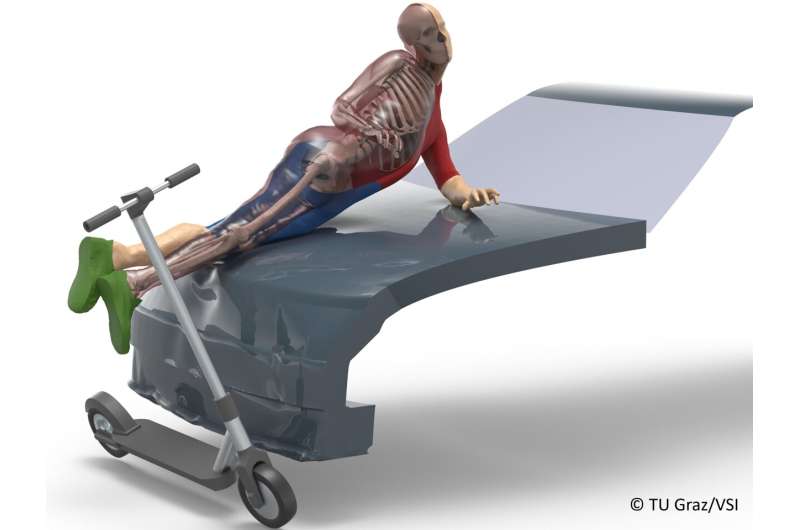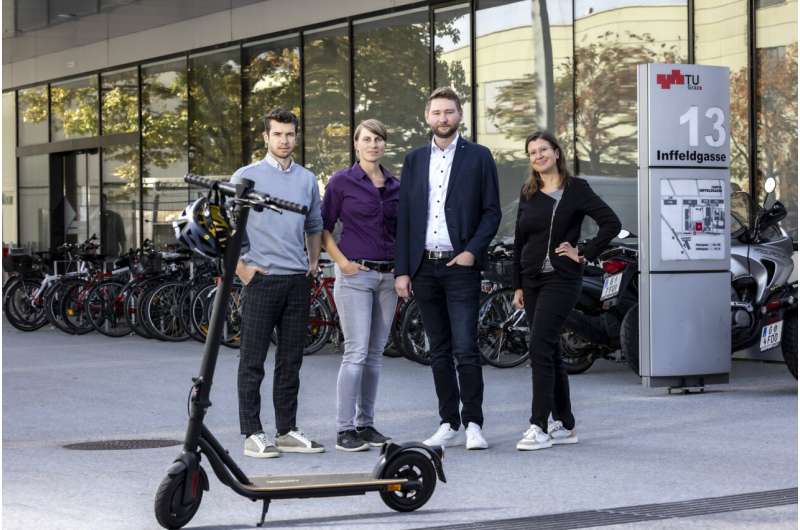Research on e-scooter accidents: More helmets and less speed reduce the injury risk

The use of e-scooters has increased significantly in recent years, but so has the number of accidents involving this relatively new form of transport. At the same time, knowledge about injury mechanisms in this area was still very limited.
In the project SURF the Vehicle Safety Institute at Graz University of Technology (TU Graz) investigated this topic using human body models and derived recommendations to reduce the injury risk in e-scooter accidents.
Put on a helmet, decrease speed and get off the pavement
As is also the case for other groups of vulnerable road users, the study found that when riding an e-scooter, a helmet can reduce the risk of head injuries drastically—in this case by up to 44%. It also showed that a ban on e-scooters on pavements and footpaths makes sense.
The simulations showed that collisions with pedestrians often result in serious injuries. In addition to the ban, a speed limit would bring more safety in this regard—the same applies to single e-scooter accidents. For example, the risk of head injuries to pedestrians is reduced by up to 49% when the collision speed is reduced from 25 km/h to 15 km/h.
In contrast, in collisions with passenger cars, it is mainly the speed of the car that plays a major role in the level of injury risk. Collisions with cars traveling at 40 km/h can cause severe to fatal head injuries to e-scooter riders.
A reduction in the maximum permitted speed of e-scooters would also benefit inexperienced drivers. As part of the study, there were experiments with volunteers in which the driving behavior of the e-scooter riders was examined in order to determine their riding pose for simulations with human body models. This showed that even inexperienced drivers often rode at the top speed of their e-scooters, although they were still very unsafe on the road.

From literature analysis to simulation
In order to obtain realistic results for the study, the team led by project manager Christoph Leo, research group leader Corina Klug, project assistant Desiree Kofler and university assistant Martin Schachner first analyzed the accident events on the basis of literature, accident records and videos in order to derive boundary conditions for the simulation.
Subsequently, the tests with volunteers to determine the riding pose were combined with human body model simulations, which were developed with the involvement of the Vehicle Safety Institute, in order to be able to predict injuries in accidents. From this, a simulation matrix could be created that made it possible to answer the project questions.
“Because e-scooters are a very young form of mobility, we broke new ground in this project in order to be able to analyze the injury risk in e-scooter accidents. There were previously not many studies on this,” explains Christoph Leo.
“However, after analyzing the simulated accidents with the Human Body Models, a very clear picture emerged. Wearing a helmet and reducing the driving speed, especially around pedestrians, can prevent many serious injuries. It would be even more important that e-scooters comply with the ban on driving on pavements and footpaths.”
“In general, the risks of this form of mobility seem to be underestimated, which is why an increasing number of injuries is expected in the coming years. You are safer in road traffic on foot or by bike and simultaneously do something good for yourself and the environment. Anyone who really needs to ride an e-scooter, please at least put on a helmet.”
Citation:
Research on e-scooter accidents: More helmets and less speed reduce the injury risk (2023, October 18)
retrieved 18 October 2023
from https://techxplore.com/news/2023-10-e-scooter-accidents-helmets-injury.html
This document is subject to copyright. Apart from any fair dealing for the purpose of private study or research, no
part may be reproduced without the written permission. The content is provided for information purposes only.
For all the latest Technology News Click Here
For the latest news and updates, follow us on Google News.

